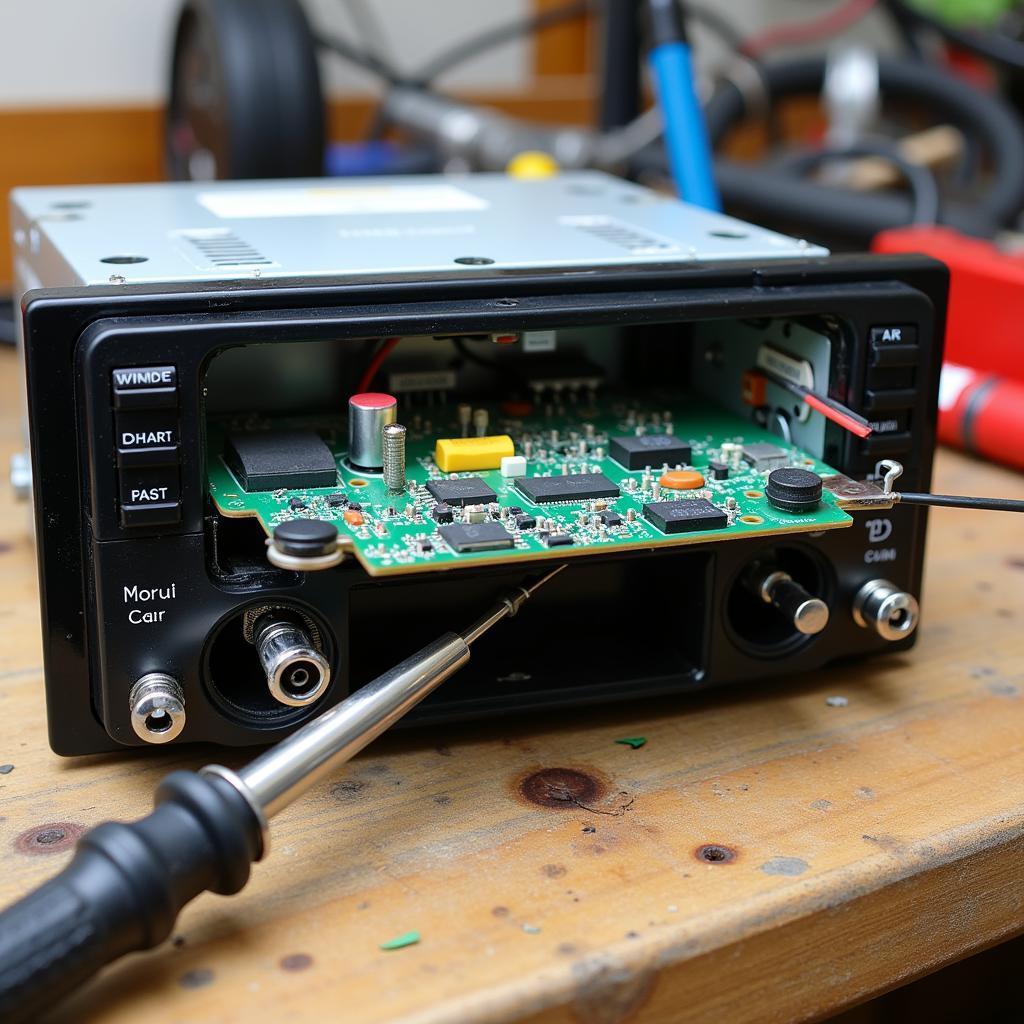Fixing a car audio system can be a frustrating experience, but it doesn’t always require a trip to a professional. This guide will walk you through diagnosing and resolving common car audio problems, empowering you to tackle the “How To Repair Car Audio System” question head-on.
First, you should identify the source of the issue. Is it complete silence, distorted sound, or intermittent problems? Knowing this will help narrow down the possibilities. Check the obvious things first, like the volume knob, power button, and any fuses related to the car audio system. A quick check can save you a lot of time and effort. Sometimes, the solution is as simple as adjusting a setting or replacing a blown fuse. If those initial checks don’t reveal the culprit, it’s time to delve deeper. This guide will cover everything from diagnosing faulty wiring to troubleshooting speaker issues and addressing head unit malfunctions. Let’s get started.
Diagnosing Car Audio Problems
Begin by checking the head unit. Ensure it’s receiving power and that all connections are secure. If the head unit powers on but there’s no sound, the problem likely lies elsewhere. Next, inspect the speakers. Look for any visible damage to the cones or surrounds. If you find problems with the bass, you might want to check out resources on how to repair car speaker bass disturbance. A multimeter can be helpful in testing the speaker connections for continuity.
If you recently tried to pair a new device and encountered problems, our guide on how to play music when car bluerooth repair might offer solutions. Similarly, for those with older systems, information on how to repair car mp3 player could be useful.
Checking the Wiring and Fuses
Wiring issues are a common cause of car audio problems. Carefully examine the wiring harnesses behind the head unit and at each speaker location. Look for any loose, frayed, or corroded wires. A faulty ground connection is another common culprit, so ensure all ground wires are securely attached to a clean metal surface. Next, locate the fuse box and check the fuses related to the audio system. A blown fuse can interrupt the flow of power and cause complete silence.
Troubleshooting Speaker Issues
Speakers are often the weakest link in a car audio system. To test a speaker, disconnect it from the wiring harness and use a multimeter to check its impedance. The impedance should match the speaker’s specifications (typically 4 or 8 ohms). If the impedance reading is significantly different, the speaker may be blown. For specific speaker issues, particularly with JBL speakers, checking if jbl car speakers repairable can be beneficial.
Repairing Common Car Audio Problems
Once you’ve identified the problem, you can begin the repair process. For simple wiring issues, you may be able to repair the damaged wires using electrical tape or by replacing the faulty section of wire. Blown fuses are easily replaced by matching the amperage rating of the old fuse with the new one.
Fixing Head Unit Problems
If the head unit is the culprit, you may need to remove it from the dashboard to access its internal components. Be careful not to damage the surrounding trim. Inside the head unit, check for loose connections, damaged components, or signs of overheating. If you’re comfortable with soldering, you may be able to repair minor circuit board issues. If the damage is extensive, replacing the head unit may be the most cost-effective solution.
 Repairing Car Audio Head Unit
Repairing Car Audio Head Unit
Replacing Car Speakers
Replacing speakers is a relatively straightforward process. Disconnect the old speaker from the wiring harness and remove any mounting screws. Install the new speaker in reverse order, ensuring a secure fit and proper wiring connections. If you experience bass issues, especially a fumbling noise, resources on how to repair car speaker bass fumbling noise may help.
Conclusion
Repairing a car audio system can be a rewarding experience. By following the diagnostic steps and repair techniques outlined in this guide, you can often fix common car audio problems yourself, saving time and money. Remember to always prioritize safety and disconnect the battery before working on any electrical components in your car. Now you know how to repair car audio system issues, empowering you to enjoy your favorite tunes on the road again.
FAQ
-
What are the most common causes of car audio problems?
Loose or corroded wiring, blown fuses, faulty speakers, and malfunctioning head units are the most common culprits. -
How can I tell if a speaker is blown?
A blown speaker often produces distorted or no sound. Testing its impedance with a multimeter can confirm a blown speaker. -
Can I repair a car audio system myself?
Yes, many car audio problems can be repaired with basic tools and some troubleshooting skills. -
What tools do I need to repair a car audio system?
A multimeter, screwdrivers, wire strippers/crimpers, electrical tape, and a soldering iron (for more advanced repairs) are commonly needed. -
Where can I find replacement parts for my car audio system?
Auto parts stores, online retailers, and even some electronics stores carry car audio components. -
How do I prevent future car audio problems?
Regularly inspect the wiring and connections, protect the system from moisture, and avoid overloading the speakers. -
What should I do if I can’t fix the problem myself?
If you’re unable to diagnose or repair the problem, consult a qualified car audio professional.
Contact Us
Need assistance with your car audio system? Our team of experts is available 24/7 to help. Contact us via WhatsApp: +1(641)206-8880 or Email: [email protected].


